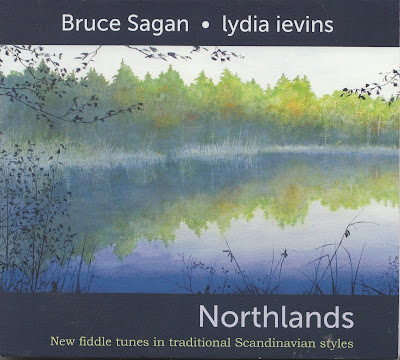
While they may fall under most people's radars, there are thriving scenes in the United States for many different types of folk music from around the world. Fans of the traditional music of Scandinavia, for example, form a small but very tightly knit community that host weekly dances in big cities like New York and in rural areas as well. Bruce Sagan and lydia ievins are prominent American fiddlers who specialize in the Swedish and Norwegian traditions. On Northlands, the pair perform a set of mostly self-composed tunes dedicated to specific musicians and dancers in the Scandinavian folk community in America.
Northlands is actually a difficult album for me to review objectively. Not only do I know Bruce Sagan, but I'm close friends with several people to whom tunes on the album were dedicated. So I'll describe the music here in some general terms, before contrasting Northlands with an album I reviewed here a few months ago. The primary style of tune or dance in Sweden is the polska, a 3/4 style with emphasis on the first and third beats. The polska may have originated in Poland, but in Sweden it has evolved into many distinct varieties, each one peculiar to a particular village. Waltzes and marches are popular as well, as are schottisches, which evolved from Scottish hornpipes. The Norwegian variant of the polska is called the pols; a typical pols is faster and more energetic than a typical polska. The melodic styles in these tunes are rooted primarily in the Baroque period, although some tunes go back a little farther than that in spirit. The tunes on Northlands reflect the Baroque side of Scandinavian music, with one fiddler playing an intricate melody while the other plays a tightly structured harmony underneath it. You can really hear the history in the style when Sagan and ievins switch from the fiddle to the nyckelharpa, a Swedish keyed fiddle. Featuring a set of droning strings underneath the four main ones, the nyckelharpa resonates with a very distinctive warmth. Sagan and ievins cover as broad a spectrum of Swedish and Norwegian fiddling tunes as you can cover on one CD, so they maintain quite a bit of variety within their two-fiddle, melody-and-harmony format.
This spring I reviewed an album called Duets Abroad by Ruthie Dornfeld, another American fiddler inspired by fiddling tradition in Scandinavia. Dornfeld works primarily with musicians from Finland on Duets Abroad, but the Finnish fiddling tradition evolved from music originally imported from Sweden. (The Finnish word pelimanni is derived from the Swedish word spelmanslag, which roughly translates as "fiddler's group.") At face value the two albums might seem similar, but they reflect very different facets of the same tradition. Duets Abroad includes some very primal-sounding tunes rooted in the Middle Ages, along with some arrangements that are very anarchic and avant-garde. By contrast, Northlands is more conventional, with more structured melodies and tight but exquisite harmonies. I'm equally fond of both albums, but I can certainly see why they might not appeal to the exact same audience.
Northlands is a fine collection of tunes in the Swedish and Norwegian fiddling traditions. Bruce Sagan and lydia ievins are both very capable composers, and their playing is superb throughout. I'm partial to "Polska til Margie" and "Kry på Dig, Carolyn! (Get Well Carolyn)" for personal reasons, but the waltz "Längtan efter Sally (Longing after Sally)" is really good as well. People in the Scandinavian folk community, here in America or elsewhere, shouldn't need my recommendation to go get this. Otherwise, anybody interested in well-played violin or fiddle music will find this worth their while as well.
Overall grade: A-
reviewed by Scott
Bruce Sagan giving a solo performance of "Get Well Carolyn"



No comments:
Post a Comment